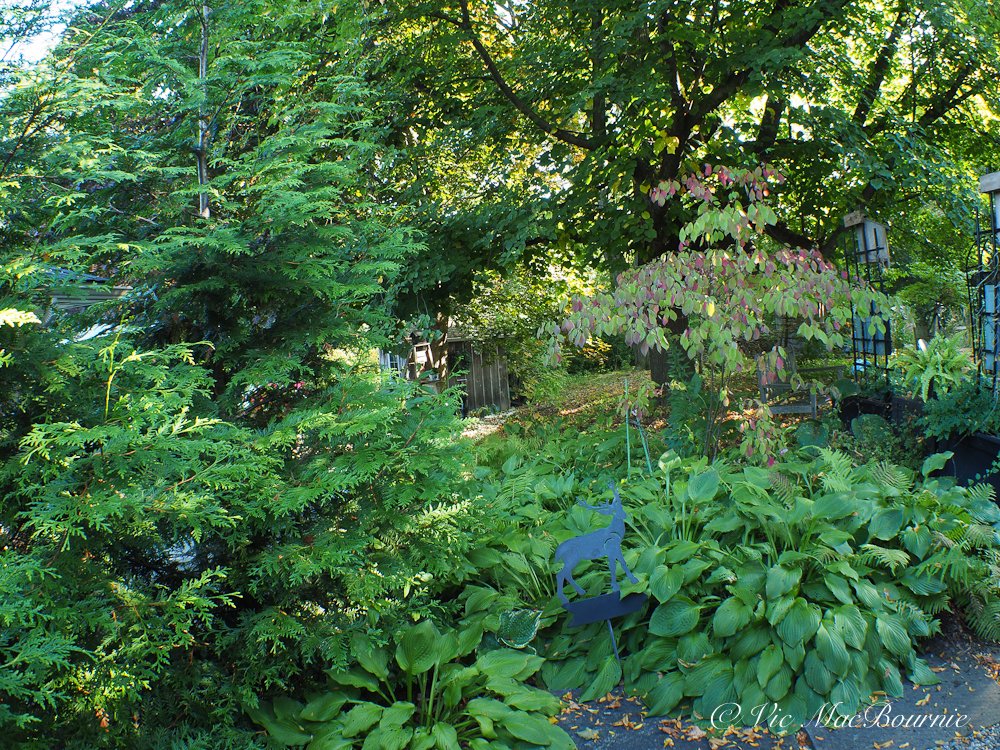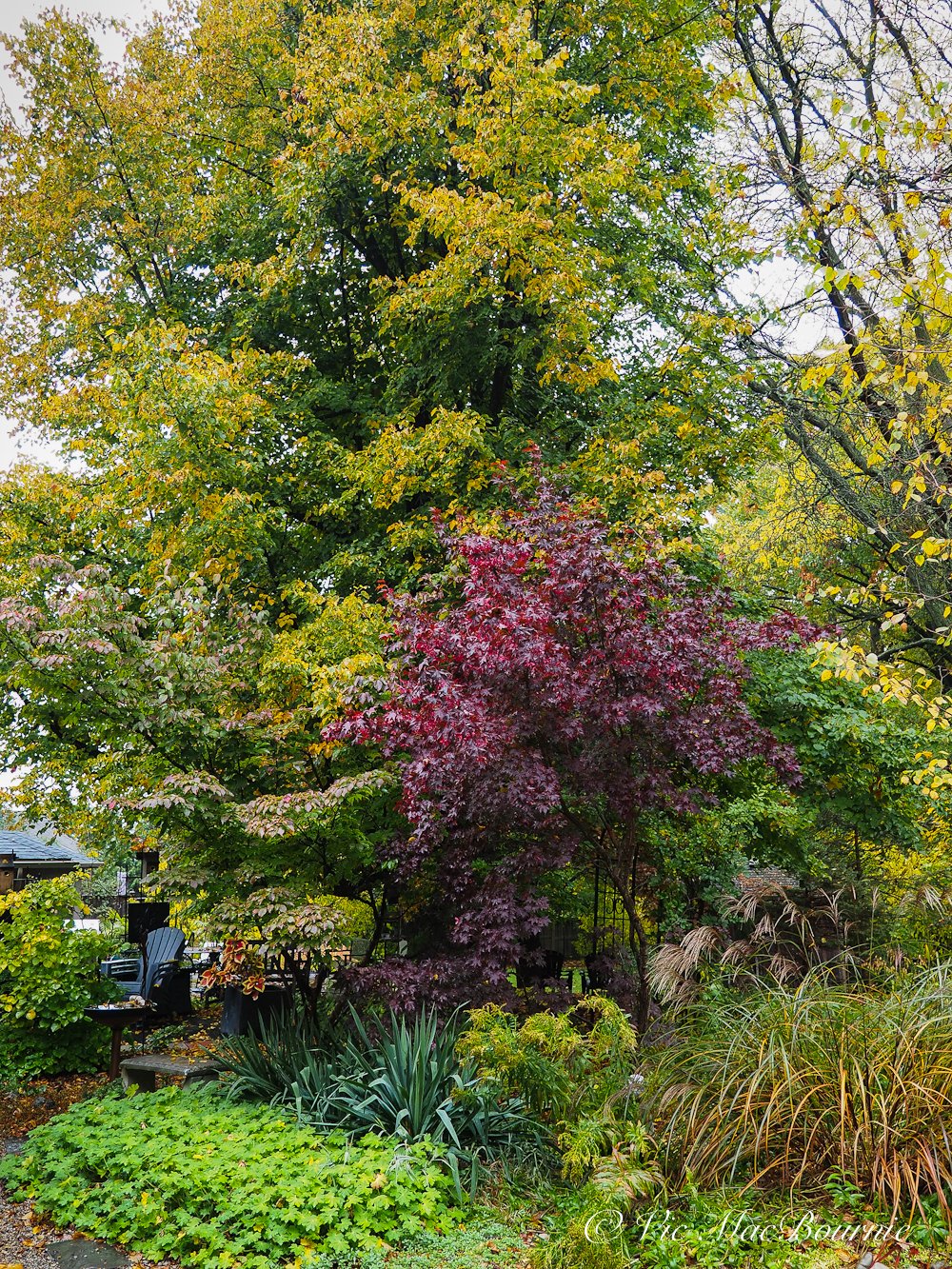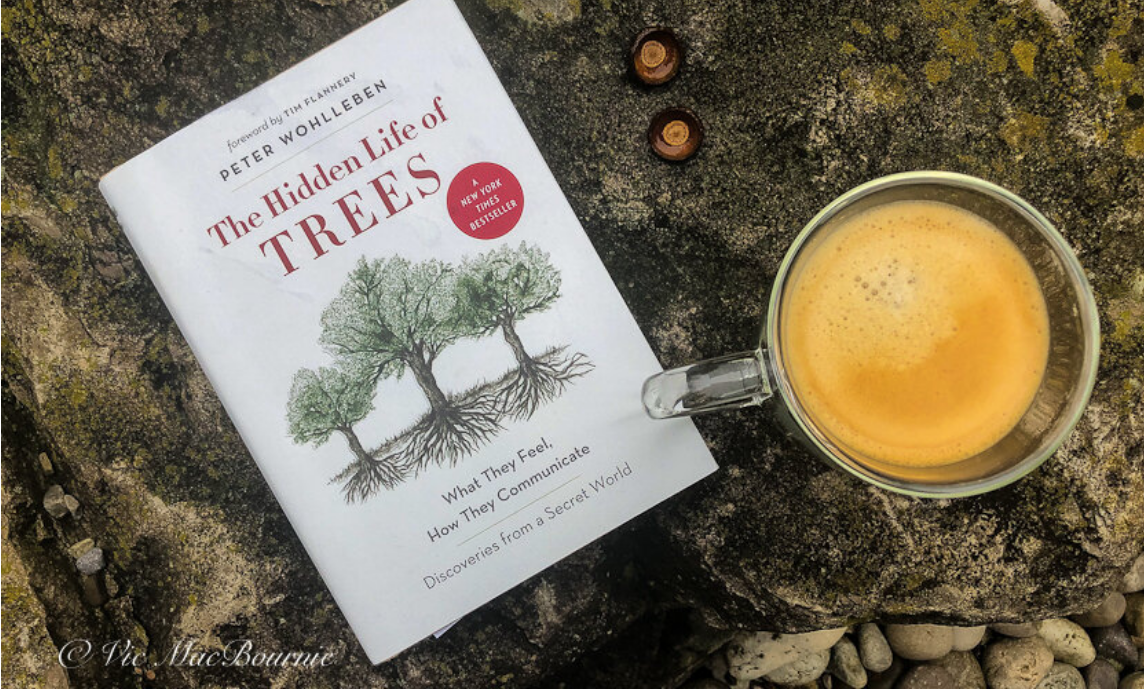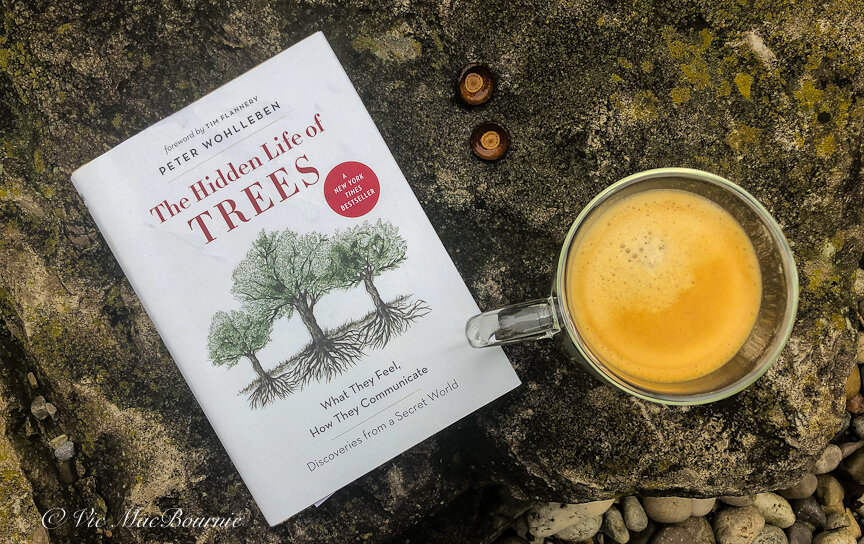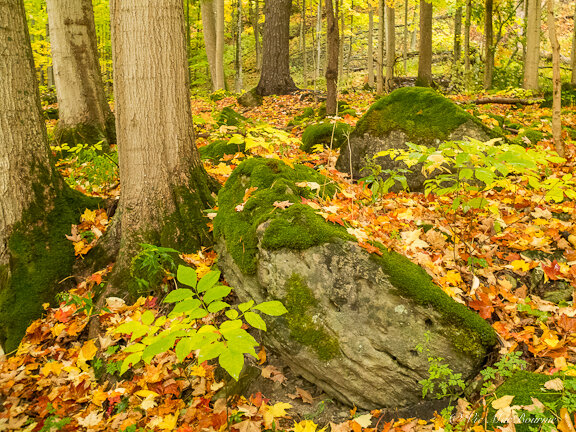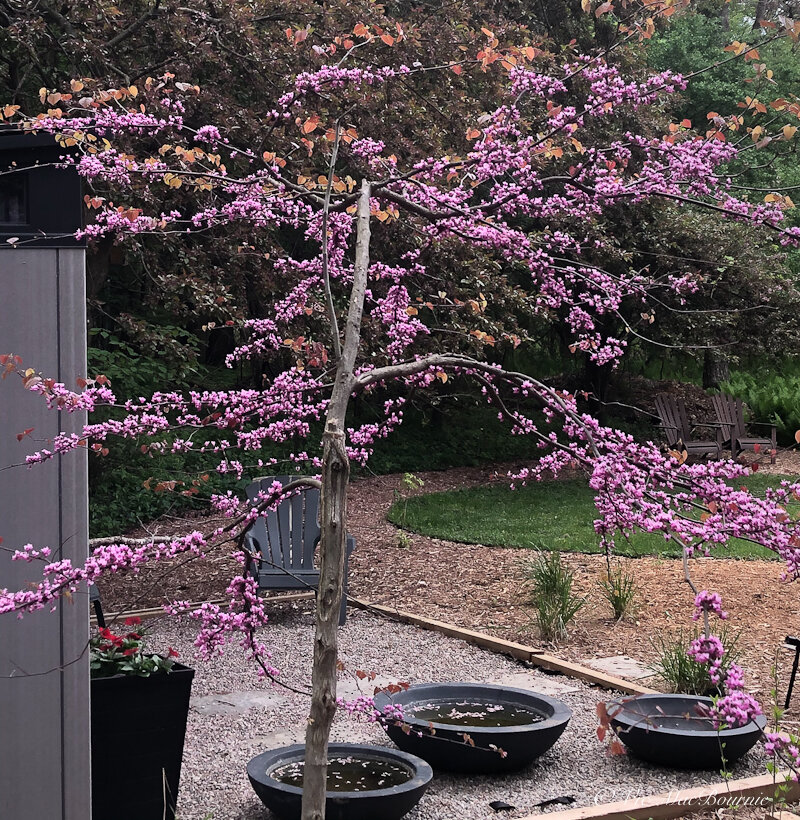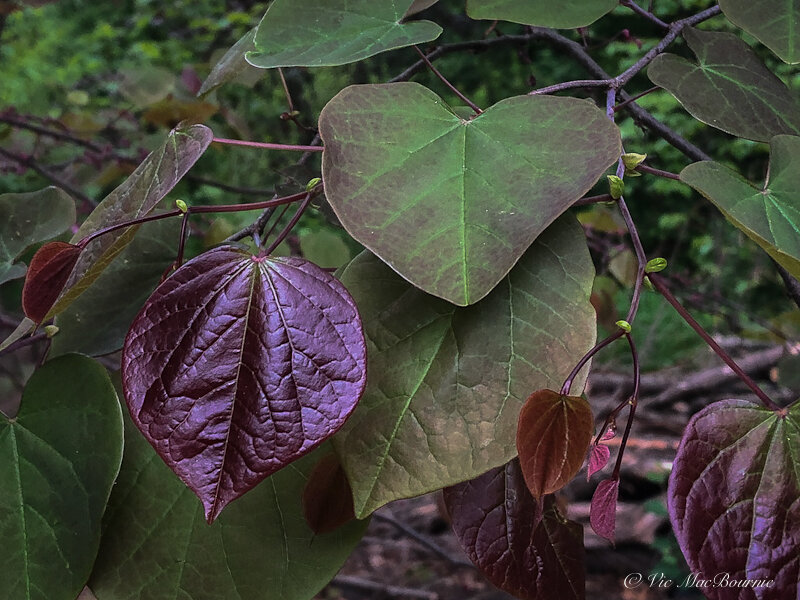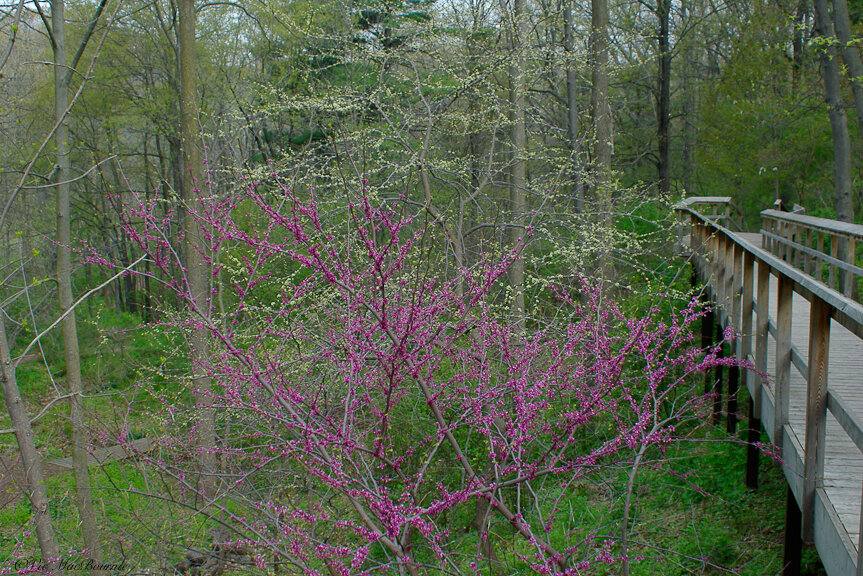Linden tree: A stalwart in our woodland garden
The Linden is an important part of our woodland garden providing deep shade in summer and habitat for wildlife as well as lovely fall colour.
How Lindens help wildlife in our yards
Not a day goes by that I don’t appreciate the beauty of our mature Linden tree in the backyard. It stands on the edge of our property just outside our family room where I can observe the many comings and goings as it changes from season to season.
It’s a favourite of our squirrels – both red and grey – backyard birds and raccoon families that use its dense branches and leaves for nesting and hiding out from summer’s full sun.
It’s not uncommon to watch our hummingbird feed from one of our feeders and then head up into the safety of our Linden tree where it can rest high in the tree’s branches or feed from its fragrant spring flowers.
Actually, Lindens have always been a part of my life.
As a child, I watched our little Linden grow up in front of me from a tiny sapling into a fully mature tree that now dominates the front of my childhood home. It became the climbing tree for my nephews and a shady play spot and picnic area for my daughter and her cousins whenever they came to visit grandma and grandpa.
In spring and summer it provides a deep shade for many of our native wildflowers, from wild geraniums to trilliums, violets and Mayapple. Our ferns and hostas also thrive in the deep shade of our massive tree.
Our Linden was a mature tree – towering above our one-storey home – when we purchased it more than 25 years ago. Little leaf Lindens can grow to about 80 feet tall (24m) with a spread between 40 to 50 feet (15m). In most urban landscapes Linden’s normally grow 40 to 50 feet (15m) tall with a 35- to 40-foot-spread.
Lindens take on a very attractive pyramidal form as they age (as seen in the larger image above). This creates a large shaded area below, making them an ideal spot for a garden bench, sitting area or small dining area.
They would be considered by some to be a little messy dropping their flowers in spring followed by small, ball-like seeds later in the year. Of course, their dense leaf cover creates a lovely deep yellow, natural groundcover in fall after they shed their leaves. I just leave them on the ground for the wildlife to use.
In spring, its bright green leaves combine with our neighbour’s mature Crimson maple leaves creating a lovely contrast that lasts throughout the growing season and create effective habitat for a host of wildlife.
How do you identify linden tree leaves?
Linden tree leaves have distinct identifying characteristics that set them apart from other tree leaves.
The key feature is their heart-shaped form, with a pointed tip and a rounded base. The edges of the leaves are serrated or toothed, adding to their unique appearance.
Another distinguishing trait is the asymmetrical leaf base, where one side is slightly larger than the other.
In terms of size, linden tree leaves are typically medium to large, ranging from 2 to 6 inches in length.
They have a smooth texture and a glossy surface, which gives them a vibrant and attractive look in the landscape. The color of the leaves varies throughout the year, transitioning from a fresh green in spring and summer to a vibrant yellow in the fall.
To further identify linden tree leaves, you can also examine the leaf veins. The veins are prominently visible and radiate from the central midrib toward the edges of the leaf. This venation pattern is characteristic of linden trees and can help distinguish their leaves from those of other tree species.
What is special about a linden tree?
Little Leaf Lindens are excellent trees to create shade in your garden.
Their dense foliage and broad canopy provide ample shade, making them a popular choice for homeowners and landscapers alike.
But what makes linden trees truly special goes beyond their shade-providing abilities.
Fragrant flowers attract bees, butterflies and even hummingbirds
One remarkable feature of linden trees is their fragrant flowers.
In late spring and early summer, linden trees produce clusters of small, yellowish-white flowers that emit a sweet, intoxicating scent. These flowers not only add beauty to the tree but also attract a variety of pollinators, including bees and butterflies.
The nectar-rich blossoms serve as a valuable food source for these insects, supporting their populations and contributing to the overall biodiversity of the area.
Medicinal uses of Linden trees and leaves
Linden leaves have long been used in traditional medicine for their calming and soothing effects.
They are often brewed into herbal teas that are believed to promote relaxation and alleviate stress. Additionally, linden leaves are known for their anti-inflammatory properties and can be used topically to soothe skin irritations and reduce swelling.
In conclusion, linden trees are not only beautiful shade trees but also play a vital role in supporting wildlife and providing medicinal benefits.
Whether you're looking to enhance your garden’s aesthetics or create a peaceful retreat, a linden tree is a special addition that will bring numerous benefits to your outdoor space.
Are linden trees native to the U.S. and Canada?
Linden trees can be grown in a variety of zones in both Canada and the United States, but are native to Europe and Asia.
These trees are adaptable and can thrive in different climates and conditions.
The ability of linden trees to grow in different zones makes them a popular choice for homeowners and gardeners looking to add beauty and shade to their landscapes. Whether you live in Canada or the United States, you can enjoy the benefits of linden trees in your garden or outdoor space.
In the United States, linden trees can be grown in zones 3 to 8, making them suitable for a wide range of states. From the northern states like Minnesota and Maine to the southern states like Texas and Florida, linden trees can be found in various regions across the country.
In Canada, linden trees can be grown in zones 2 to 7, which cover a large portion of the country. This means that linden trees can be enjoyed in regions such as British Columbia, Alberta, Ontario, and Quebec, among others.
With their attractive foliage, fragrant flowers, and the wildlife they support, linden trees are a valuable addition to any garden or woodland area. So, if you're considering planting a linden tree, rest assured that it can thrive in the appropriate growing zones in both Canada and the United States.
What are linden leaves good for?
Linden leaves are not only beautiful, but they also have several practical uses.
One of the main benefits of linden leaves is their medicinal properties. These leaves have been used for centuries in traditional medicine to treat various ailments. They are known for their calming and soothing effects, making them a popular choice for herbal teas and infusions.
Linden leaf tea is often consumed to help with anxiety, stress, and insomnia.
In addition to their medicinal uses, linden leaves are also beneficial for the environment. They are rich in nutrients and can be used as a natural fertilizer for plants. By composting linden leaves, you can enrich the soil and promote healthy plant growth.
Linden are host plant for certain insects and caterpillars
Furthermore, linden leaves are a valuable food source for certain insects and caterpillars. They provide nourishment for species such as the linden looper moth and the linden hawk moth. These insects play an important role in the ecosystem as pollinators and as a food source for other animals.
So, while linden trees are admired for their shade and fall color, their leaves offer even more benefits. From their medicinal properties to their role in supporting wildlife, linden leaves are truly valuable. Whether you’re enjoying a cup of linden leaf tea or observing the insects that depend on them, linden leaves are a wonderful asset to have in any garden or woodland area.
What animals, insects, and birds depend on Linden
These trees attract a wide range of animals, insects, and birds, making them an important part of any woodland garden or natural habitat.
One of the main beneficiaries of linden trees are butterflies. Species such as the Eastern Tiger Swallowtail and the Red-spotted Purple rely on linden trees as a food source for their caterpillars. The leaves of the linden tree provide nourishment and support the growth of these beautiful butterflies.
In addition to butterflies, linden trees also attract a variety of birds. Species like the American Goldfinch and the Ruby-throated Hummingbird are known to visit linden trees for their nectar-rich flowers. These birds play a crucial role in pollination and contribute to the overall health of the ecosystem.
Furthermore, linden trees provide shelter and food for mammals as well. Squirrels and chipmunks are often seen scurrying up and down the trunks of linden trees, collecting seeds and nuts.
These trees also offer a safe haven for nesting birds and provide a habitat for small mammals like bats.
Linden tree: An ideal tree for a woodland garden
In conclusion, linden trees are not only visually appealing but also support a diverse range of wildlife. From butterflies and birds to mammals, these trees play a vital role in providing food, shelter, and habitat for various species. By planting linden trees, you can create a thriving ecosystem in your own backyard.
How trees communicate in our woodland gardens: The Hidden Life of Trees
The Hidden Life of Trees is a New York Times bestseller every Woodland Gardener needs to read. Author Peter Wohlleben explores how trees communicate in nature and how they struggle in urban environments calling them “street kids” and explaining the difficulties they face in our woodland gardens and on urban environments.
Do trees work together to help one another?
If you love trees – and I know every woodland gardener does – then you need to get The Hidden Life of TREES. (Amazon Link)
Peter Wohlleben’s 288-page, New York Times best seller will open up a new world for Woodland gardeners looking for answers about what is really going on in their backyards, local woodlots and ancient forests.
There is a reason this book has sold more than 2 million copies. Canadian publisher Greystone Books unleashed the book in its 8th printing on September, 2016 in the First English Language Edition, and has never looked back. (A fully illustrated coffee-table version is also available, see below.)
Not convinced about the importance of this book, consider that it has also been made into a movie. Check out this YouTube link for a taste of The Hidden Life of Trees movie version. (It will be available on AppleTV starting the month of October.)
It should come as no surprise to any of us that several backyard trees work together to create their own environment – from cooling our yards with shade to creating their own fertilization and micro environments at ground level.
Sit back and relax with a good coffee and The Hidden Life of Trees. The New York Times best seller is a must for Woodland gardeners.
What will come as a surprise to most of us, however, is the incredible goings on under our feet – from just a few inches beneath the soil to the depths many of our mighty tree roots reach. Beneath the soil there’s a communication highway where battles are waged, where life and death struggles play out through the seasons, and where families of trees come together through the “Mother Tree” and work together, sometimes over centuries, to survive, and ensure the health and prosperity of the woodland.
If you are looking to purchase the Hidden Life of Trees, or any other gardening book for that matter, be sure to check out the outstanding selection and prices at alibris books.
Armed with this knowledge, woodland gardeners can begin to make sense of so many questions about our gardens; its forest canopies, why a variety of tree is not flourishing and how we can help our woodland thrive.
(Dr. Nadina Galle has taken her inspiration from The Hidden Life of Trees and The Heartbeat of Trees and used it as a building block in her groundbreaking work to use smart technology to monitor the health of the urban forest. Read about her outstanding work here in my recent article The Internet of Nature.)
But this is not a how-to book. There are no pictures of trees. There are no outright tips for how to plant trees, where to plant them or when to plant them.
The Hidden Life of Trees: What They Feel, How They Communicate is a book that explores the often mysterious lives of individual trees, of forests, of trees left alone to fend for themselves in urban areas, on our streets and in our backyards. This is a book, written by a German forester, about how trees have communicated with one another over decades and even centuries, how they work together to save their own against disease, natural disasters, man’s destructive habits and the invaders we have brought that threaten the very existence of our native trees. Underlying it all, is the affect climate change is having and will continue to have on our woodlands, our urban forests and ancient rainforests.
“Life as a forester became exciting once again. Every day in the forest was a day of discovery. This led me to unusual ways of managing the forest. When you know that trees experience pain and have memories and that tree parents live together with their children, then you can no longer just chop them down and disrupt their lives with large machines.”
Trees work
Will a single tree thrive in my yard?
The author makes it clear from the beginning that the lone tree in the middle of our front and back yards surrounded by grass that is so prevalent in many urban homes, is not an ideal situation for a tree’s prosperity.
“A tree is not a forest. On its own, a tree cannot establish a consistent local climate. It is at the mercy of wind and weather. But together, many trees create an ecosystem that moderates extremes of heat and cold, stores a great deal of water, and generates a great deal of humidity. And in this protected environment, trees can live to be very old. To get to this point, the community must remain intact no matter what. If every tree was looking out for only itself, then quite of few of them would never reach old age.”
The above quote may well explain why our urban trees rarely reach maturity, let alone old age. Where I live, this is clearly evident in local birch trees. In the heart or our urban communities these trees rarely survive into maturity. In the older, more rural areas where trees are less crowded and are given more room to grow, Birch trees seem to do much better. In my yard, I have planted three clumps quite close to one another and they seem extremely happy, possibly beginning to communicate with one another.
As trees struggle on their own, some would die opening up the forest floor to sunlight, the author explains. “The heat of summer would reach the forest floor and dry it out. Every tree would suffer.”
Do trees help one another survive?
If we conclude that every tree is valuable to the forest community and worth keeping around, it should come as no surprise that, as Wohlleben writes, “…even sick individuals are supported and nourished until they recover.”
He compares them to a herd of elephants. “like the herd, they, too look after their own, and they help their sick and weak back up onto their feet. They are even reluctant to abandon their own.”
If you have never thought about trees in this way, you may be shocked about how deep Wohlleben goes to explain just how extensively trees communicate through primarily – but not limited to – underground networks.
For the doubters, let me just say that his arguments and scientific data are hard to ignore.
Five key takeaways from this book
• Trees are much more complicated than most of us realize and their means of communication are complex and sophisticated.
• The importance of planting a grouping (possibly an island or a grove if possible) of the same variety of native trees is much more beneficial than planting individual specimens, especially if they are non-native trees.
• Recognizing that a tree’s needs must be met not just after initial planting but long into their growth cycle is important, and reducing physical barriers can be critically important.
• Single trees planted in our yards are more on their own than we might realize, and it matters that they cannot communicate easily with other trees. Best to take extra care of these lone trees.
• A woodland garden thrives not only because it is more natural than say a cottage garden, but because trees work together to create a positive environment that helps to guarantee success even when they are threatened.
Can trees communicate?
Consider that four decades ago, scientists noticed an interesting phenomenon on the African savannah.
They noted that giraffes feeding on acacia trees moved on quickly to other trees. The same scientists discovered that mere minutes after the giraffes began feeding on the trees, the acacias began pumping toxic substances into their leaves to ward off the large herbivores. The giraffes moved on, walked past a number of nearby acacias, before resuming their feeding on a group of trees about 100 yards away.
“The reason for this behavior is astonishing. The acacia trees that were being eaten gave off a warning gas that signaled to neighbouring trees of the same species that a crisis was at hand. Right away, all the forewarned trees also pumped toxins into their leaves to prepare themselves…. The giraffes were wise to this game and therefore moved farther away … to a part of the savannah where they could find trees that were oblivious to what was going on.”
The entire book is filled with fascinating stories about how trees’ self defences are used to ward off fungal diseases, beetle attacks and even how they deal with woodpeckers and other potentially destructive mammals that depend on trees for their own survival.
This is just an example of the many ways trees may communicate in a natural environment. The book goes on to explain a myriad of ways trees communicate, but in doing so, it also explores the many ways communication between trees is cut off leaving orphaned trees alone and fending for themselves.
Communication between trees growing in managed forests and in many of our urban parks is often restricted and underdeveloped for a variety of reasons explored in the book.
How are single trees like “street kids”?
But it’s the chapters on street kids that many gardeners and homeowners will likely focus on the most.
A drive down a suburban street or through a large city reveals just how many trees are left alone to fend for themselves.
In his book, Wohlleben describes these orphaned trees as “street kids.”
“Urban trees are the street kids of the forest. And some are growing in locations that make the name an even better fit – right on the street. The first few decades of their lives are similar to their colleagues in the park. They are pampered and primped. Sometimes they even have their own personal irrigation lines and customized watering schedules.”
The problem comes when these trees decide it’s time to go out and establish themselves. They quickly meet with hard, unlivable soil and even concrete walkways, roads that don’t allow any water to penetrate down into the hard soil compacted by machinery
“When trees are planted in these restrictive spaces, conflicts are inevitable….The culprit is sentenced to death.”
It is cut down and another planted in its place, but the new one is planted in a built-in root cage to restrict its roots from ever causing damage to the surrounding hardscaping.
Sound familiar?
What problems does a single tree face?
The difficulties “street kids” face does not end there. In large urban areas, where the lights never go out, these trees never get a chance to rest. They need a period of rest to thrive. Often, the concrete traps heat and even winters, another time for the tree to rest, are non-existant.
The sun, too, heats the concrete and black asphalt to the point of killing any living organism in the soil beneath it, depriving the “street kids” of water and nourishment.
In large urban areas these problems are obvious, but take a look around at your own trees and consider if they are facing some of these same problems.
Are the roots of the tree in your front yard growing under the road? Would additional watering help it survive hot, dry periods?
Is your favourite dogwood struggling because it is now in bright sunlight most of the day after a neighbour cut down a large maple exposing it to harsh sunlight? Maybe we need to add a large shade tree nearby to reduce the amount of sunlight hitting the dogwood.
Is your concrete driveway cutting off all water to your favourite roadside maple tree? Maybe it’s time to do what I did and replace the old asphalt or concrete with stone or permeable brick to allow water to seep down into the roots of the tree. Not only will it help the tree, it also reduced the amount of toxic runoff from your driveway into the sewer systems by keeping more water on your property.
As I said earlier: this is not a how-to book, but it certainly provides food for thought about how we can help our own little forest survive and thrive in our woodland garden.
About the Author: Peter Wohlleben spent over twenty years working for the forestry commission in Germany before leaving to put his ideas of ecology into practice. He now runs an environmentally-friendly woodland in Germany, where he is working for the return of primeval forests. He is the author of numerous books about the natural world including The Hidden Life of Trees, The Inner Lives of Animals, and The Secret Wisdom of Nature, which together make up his bestselling The Mysteries of Nature Series. He has also written numerous books for children including Can You Hear the Trees Talking? and Peter and the Tree Children.
If you like the Hidden Life of Trees, be sure to check out its sequel The Heartbeat of Trees recently published.
Plant the perfect Redbud (a Carolinian zone favourite)
I consider the Eastern Redbud equal to Dogwoods when it comes to understory trees in the Woodland Garden. It’s incredible spring bloom turns into a green architecturally elegant tree in the summer that comes to life again in autumn with its spectacular canary-yellow fall foliage. What’s not to love about this native understory tree that lights up the spring landscape with its pink blooms and the fall landscape with its golden leaf colour.
Forest Pansy is a real winner in a forest of Redbuds
I’ve always liked Redbuds, but it took a local garden tour for me to fall in love.
With the Redbud, that is. It wasn’t just any Redbud tree, either. It was the Forest Pansy Redbud.
Cercis Canadensis, or the Eastern Redbud, as it is known in gardening circles, is a Woodland tree growing in zones 4-9, native to southern Ontario and most of the United States from northern Florida as far west as California. There are actually a few different varieties of redbud trees, including a Texas Redbud and a Mexican Redbud as well as a Western Redbud (which is a separate species, cercis orbiculata).
Eastern Redbud is part of the Carolinian Canada zone
The Eastern Redbud is the largest of the group, requiring the most water. The tree, which is part of the Carolinian Canada zone, also has larger, less glossy leaves than the other varieties. It grows to about 30 feet with a spread of about 35 feet and can be found as a multi-stem tree or large shrub, to a single-stem specimen. It can take full sun but likes a little light shade as an understory tree in the woodland garden where it puts on its glorious show in early spring with an abundance of pink flowers on bare branches.
For those not familiar with the Redbud, think back to early spring and seeing a small tree with a profusion of tiny pink flowers covering the branches of the entire tree before the heart-shaped leaves had begun to emerge. Remember thinking to yourself, ‘holy smokes what is that’? Well folks, that was a Redbud.
Our Redbud Forest Pansy in its spring bloom in mid May. The Forest pansy leaves emerge with rusty-coloured leaves that can be stunning in the woodland garden. They are a favourite for leaf-cutter bees that cut perfectly round holes in the leaves to line their nest.
Now if a spectacular fireworks of pink, pea-sized blossoms on bare stems in early spring isn’t enough, how about the fact that the tree’s horizontal growth habit gives it a beautiful architectural quality in the garden if, of course, it is left to grow in a natural state and not attacked by a chainsaw or some other tool of destruction.
Still not enough?
The leaves are 2 to 6-inch, heart-shaped and turn a dark green throughout the summer only to turn a spectacular bright canary yellow for fall. They attract many species of birds, bees and butterflies and will grow in most decent soils. They are deer resistant. The deer in my area, at least, have never bothered mine.
The trees are even so beloved that there are Redbud festivals in Texas, Virgina and Wisconsin, just to name a few.
They are also one of the few trees that leaf-cutter bees use to line their nest cavities. Look closely for circles cut out of the edge of the leaves, and you’ll know you have native leaf-cutter bees nesting in your garden. That’s a very good thing. You can rejoice in the fact that the bees cut holes in your leaves rather than trying to find the culprit crawling on the leaves.
I consider the Redbud equal to the Dogwoods as the best understory trees for the Woodland garden. At present I have three in the garden, including a Forest Pansy. The others are a multi-stem Eastern Redbud I added this year to join our single stem tree.
Early spring leaves on the Redbud Forest Pansy.
The Forest Pansy’s leaves are different
And we have not yet even talked about the Redbud I fell in love with. The Forest Pansy is actually a cultivar of the common Eastern Redbud. It has all the best qualities of the original Redbud but the leaves are a more intense red-purple hue. The tiny leaves grow into deep, shiny, leathery looking purple-colored, heart-shaped leaves.
The one I saw on the garden tour was incredible. At first, I didn’t know what to think of the leathery leaves. They almost looked like the tree was going into decline, but of course, it was not.
With that in mind, the Forest Pansy may not be a tree for everyone. Its unique summer colour might be too much for some gardeners to overlook. It is, however, the perfect specimen tree to get the attention of passersby on a garden tour. It might also work as a garden focal point in a Meditation Garden or an Asian-inspired Japanese garden.
Whether it’s a Forest Pansy cultivar or the common Eastern Redbud, consider planting them on the edge of your woodland alongside some dogwoods where you can fully appreciate them. They work beautifully in the natural landscape in groupings of three to five planted together to create an incredible view from a deck or window overlooking the garden. Underplant them with spring bulbs to create truly memorable spring garden designs.
A beautiful Redbud in bloom along a nature trail at the Royal Botanical Gardens in Burlington Ont.
A perfect example of mature Redbuds used in the landscape can be seen in the garden of Linda Vater. Not only are her Redbuds beautifully pruned to accentuate their natural horizontal branching habits, but her use of evening lighting makes the trees a standout in her garden both day and night. The above link takes you to an evening image of her garden with lighted Redbuds. Her YouTube channel is definitely worth checking out for more views of her Redbuds in the back garden.
If you remember one of my earlier blogs on some of the best nurseries to purchase native plants, we talked about Ontario Native Plants mail order company from the Hamilton area. They list Eastern Redbud for about $7.00. If you have the time to wait for them to grow, that’s a pretty darn good price.
Larger specimens can be purchased at most good local nurseries in tree form or multi-stemmed.
Looking for more information on our native Redbud? You might consider this e-book Kindle version from Amazon.
More links to my articles on native plants
Why picking native wildflowers is wrong
Serviceberry the perfect native tree for the garden
The Mayapple: Native plant worth exploring
Three spring native wildflowers for the garden
A western source for native plants
Native plants source in Ontario
The Eastern columbine native plant for spring
Three native understory trees for Carolinian zone gardeners
Ecological gardening and native plants
Eastern White Pine is for the birds
Native viburnums are ideal to attract birds
The Carolinian Zone in Canada and the United States
Dogwoods for the woodland wildlife garden
Bringing Nature Home by Douglas Tellamy
A little Love for the Black-Eyed Susan
Native moss in our gardens
This page contains affiliate links. If you purchase a product through one of them, I will receive a commission (at no additional cost to you). Thank you for your support. This blog would not be possible without your continued support.

